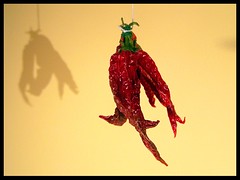The Columbian Exchange has been one of the most significant events in the history of world ecology, agriculture, and culture, says Wikipedia. The term is used to describe the enormous widespread exchange of plants, animals, foods, human populations (including slaves), communicable diseases, and ideas between the Eastern and Western hemispheres that occurred after 1492.
Many new and different goods were exchanged between the two hemispheres of the Earth, and it began a new revolution in the Americas and in Europe. In 1492, Christopher Columbus' first voyage launched an era of large-scale contact between the Old and the New Worlds that resulted in this ecological revolution: hence the name "Columbian" Exchange.
One example from the New World:
Chili peppers have been a part of the human diet in the Americas since at least 7500 BC and perhaps earlier. There is archaeological evidence at sites located in southwestern Ecuador that chili peppers were already well domesticated more than 6000 years ago,[1][2] and is one of the first cultivated crops in the Americas that is self-pollinating.
Chili peppers are thought to have been domesticated at least five times by prehistoric peoples in different parts of South and North America, from Peru in the south to Mexico in the north and parts of Colorado and New Mexico (Ancient Pueblo Peoples).[3]
Christopher Columbus was one of the first Europeans to encounter them (in the Caribbean), and called them "peppers" because of their similarity in taste (though not in appearance) with the Old World peppers of the Piper genus.
Chilies were cultivated around the globe after Columbus' time.[4][5] Diego Álvarez Chanca, a physician on Columbus' second voyage to the West Indies in 1493, brought the first chili peppers to Spain, and first wrote about their medicinal effects in 1494.
From Mexico, at the time the Spanish colony that controlled commerce with Asia, chili peppers spread rapidly into the Philippines and then to India, China, Korea and Japan with the aid of European sailors. The new spice was quickly incorporated into the local cuisines.
Read more on the Columbian Exchange.
Subscribe to:
Post Comments (Atom)


No comments:
Post a Comment